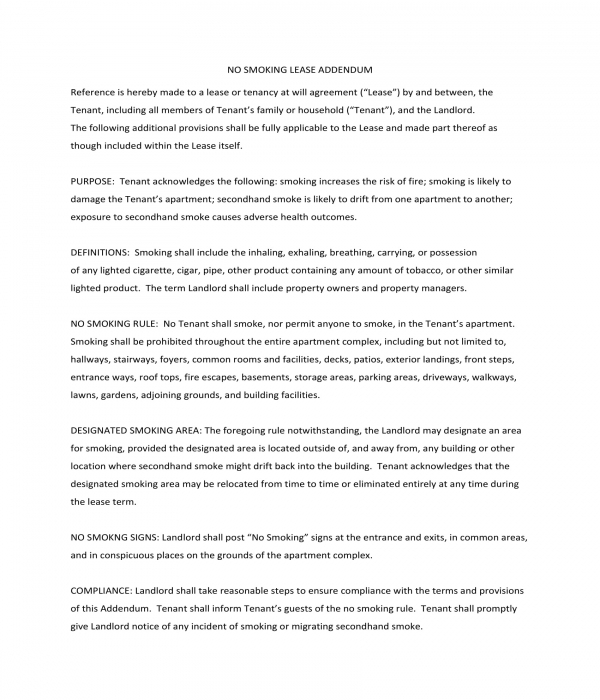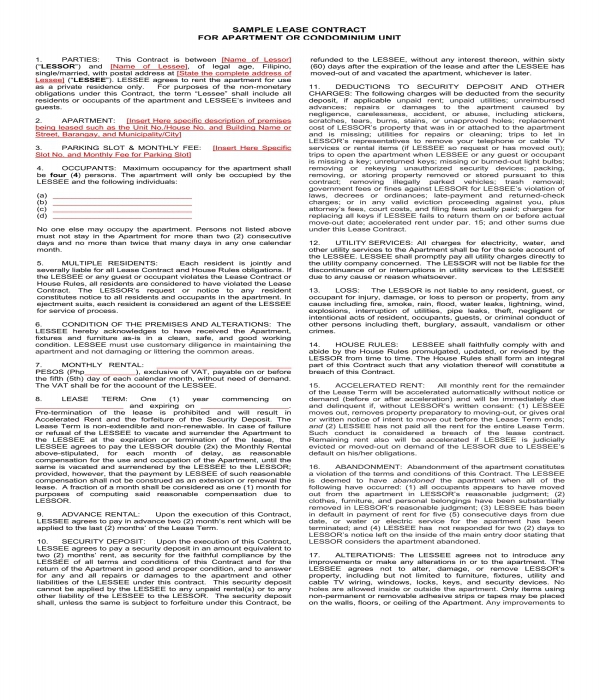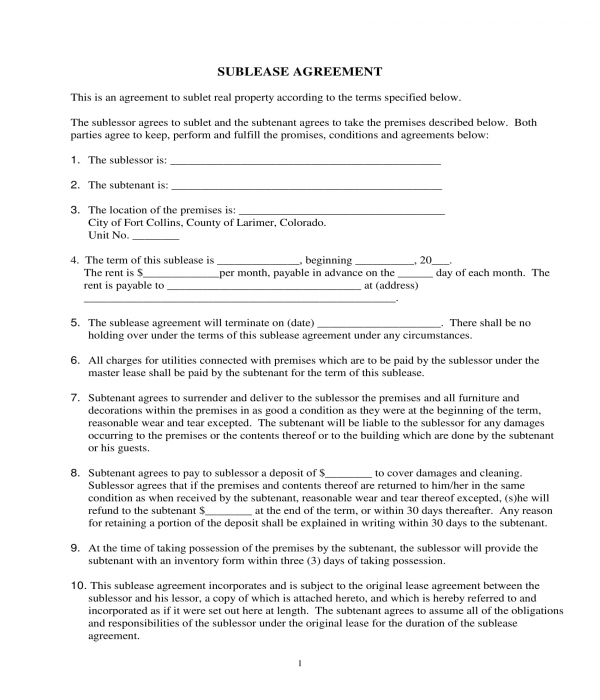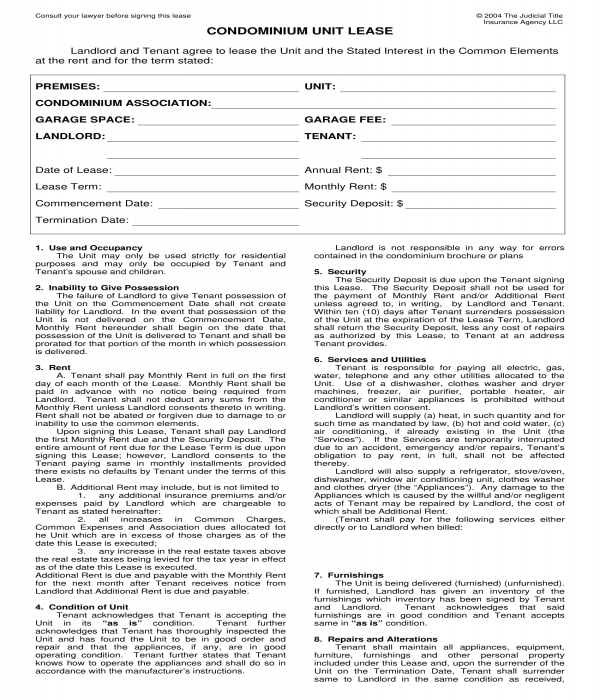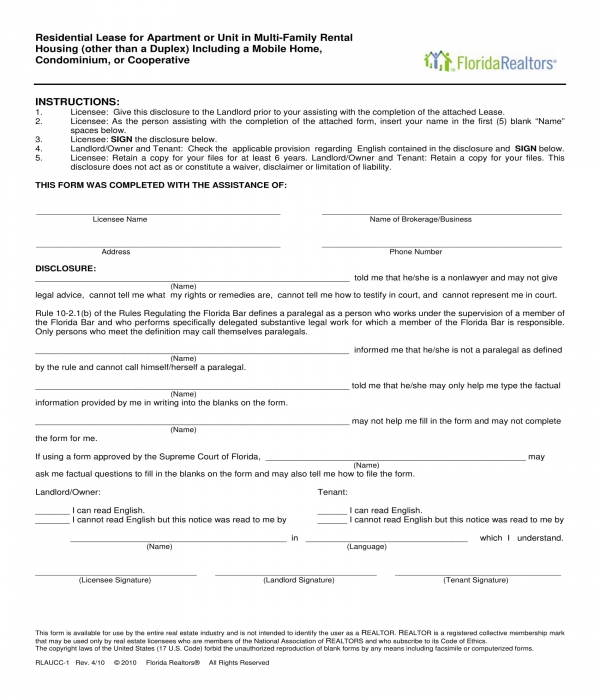Building and owning a house is expensive for the general population. This is the reason why tons of apartment options are being offered to those who are seeking shelter yet still will want to build a home. Apartments are small housing units and are more affordable than purchasing or even renting a house. However, nowadays, apartments are being built in groups or in buildings which results in a new type known as condominiums or condos. These condominiums do not only hold apartments on every floor but also other amenities such as gym and exercise centers, swimming pools, and clubhouses or event venue places. Similar to leasing a house or a property, a condominium must also be rented out with the right documentation including a condominium rental agreement form.
- Standard Rental Agreement Forms
- Rental Lease Agreement Sample Forms
Apartment Condominium Rental Lease Agreement Form
What Is a Condominium Rental Agreement Form?
A condominium rental agreement form is a crucial document to prepare by the property owner and to be acquired by the tenant. This is a type of legal form which should be agreed by both the tenant and the property owner regarding the lease of the condominium. In the form, the terms and conditions which are required by the property owner and the other agreed payments, options, and addendums of the tenant will be stated. With a properly constructed and negotiated agreement, both the tenant and the property owner will be protected and will have better communication compared to relying on verbal agreements alone.
Condominium Rental Lease Agreement Addendum Form
Condominium Rental Lease Agreement Contract Form
Elements of a Condominium Rental Agreement Form
There are seven main elements of condominium rental agreement forms that all involved parties must note when using the document. Below are the following:
- The offer of the property owner. The details of the condominium property which is being offered is one of the most important to discuss in the agreement form. This should also state the inclusions such as the parking space, the use of other amenities, and the maintenance responsibilities of the parties involved, either the tenant or the property owner himself.
- The acceptance of the tenant. The form must clearly state that the tenant accepts all the offer indicated in the agreement. By indicating the tenant’s acceptance, there is proof that both the tenant and the property owner have met and have negotiated in order to arrive at an agreement.
- The considerations agreed by both parties. This refers to the agreed roles of both parties. For instance, the tenant is the person who is responsible to provide the payments and will secure that the property is taken care of during his residence in the property, while the property owner is the landlord who will be obtaining the tenant’s payments every month.
- The competence of both parties. This element refers to the capabilities of the parties involved in meeting their obligations and in being a participant in the rental agreement or contract form. One of the basic competency requirement is that each party should be beyond the minority age which is beyond eighteen years old. Another is the work or employment status of the tenant which should provide enough salary amount so that the tenant can pay on time for his rental fees and payments.
- The consent of the tenant and the landlord. Documenting that the parties involved have mutually agreed and have given their consents to be part of the agreement is important due to the one main reason which is to ensure that both parties did not enter in an agreement against their own will.
- The legality of the condominium rental business. A condominium rental agreement will only be accepted as a legal form if the business and the property owner have registered properly in the State and in various agencies who govern businesses related to property rentals and ownership.
- The agreement must be documented in writing. Yes, an agreement can be done verbally however, the court and any organization will not cater verbally committed agreements since there will not be enough proof for any claim.
Condominium Sublease Rental Agreement Form
Condominium Unit Lease Agreement Form
Steps to Make an Effective Condominium Rental Agreement Form
Making an agreement form requires the legal expertise of the document-preparer since it is important that the terms, conditions, and the regulations stated in the content of the agreement are all aligned to rules and the laws of the State where the property is located and registered. Below are the steps to follow in order to create an effective and standardized condominium rental agreement form:
Step 1: State the title of the form.
The title of the form should be on the topmost portion along with the name of the real estate agent if applicable. In addition, an area for the date when the form is used can also be considered with the indication for the document number.
Step 2: Define the parties.
The names of the tenant or the renter and the property owner who is the landlord will be stated in this section. Their individual addresses and contact information must also be included.
Step 3: Describe the property.
It is essential that the property description is complete ranging from the location of the property up to its specific measurement in square meters are stated. Another important information to include is the name of the person who is managing or taking care of the property especially since a condominium establishment and the condominium space can be of different owners and managers.
Step 4: Indicate what State law is observed in the agreement.
Each State and country will have varying laws to mandate when it comes to establishing and observing a tenancy business and rental agreement. For instance, in Newfoundland Canada, they mandate the Residential Tenancies Act for their residential businesses.
Step 5: Disclose the tenancy term.
The tenancy term refers to the actual number of months or years for the tenant to reside in the condominium property. The date when the tenant will begin his stay and when his tenancy will end should be indicated in this section in order to acknowledge the time and document the accountability of the parties involved.
Step 6: Clarify the rental fees and payments.
The detail of how much the tenant will have to pay and when he is expected to provide the payment is the information to be catered in this section of the form. Moreover, information about possible rental increases can also be included especially if the condominium rental is not for a fixed term.
Step 7: Enlist the included facilities and amenities.
The water supply, heat sources, gym facilities, and even the swimming pool and clubhouse should be enlisted if condominium property includes these in the rental payment of the tenant. On the other hand, if there are additional payments to be given in order to be able to use the facilities, then it must be stated in the form as well along with their corresponding fees or payment amounts. Other responsibilities of the tenant can also be listed such as the payment for the electrical bills and room maintenance for damaged items in the property.
Step 8: Identify the other occupants.
If the condominium unit is suitable to be used by multiple occupants and if the tenant will be staying in the property along with his family members or friends, each of the occupants’ names must be identified in the agreement. This is to secure and ensure that the occupants in the property or the condominium unit are indeed the documented tenants stated in the agreement form.
Step 9: Include a security deposit statement.
A security deposit is a specific amount which is to be paid by the tenant along with the rental fees. The deposit is also often intended to be used by the landlord for repairing broken items included in the rental agreement of the tenant once the tenant’s term is terminated or has come to its end. In addition to the security deposit, a landlord can also require his tenant to give a reservation and initial payment prior to beginning the contract. This depends however on the agreement and the negotiation of the tenant and the landlord.
Step 10: State termination rules and statutory conditions.
How a rental or lease termination be conducted by the landlord will be stated in this portion of the form. Common termination options are three months prior to the date of termination and even seven days before the date of the mandatory move out of the tenant from the property. The statutory conditions, on the other hand, will state the obligations of both parties along with other rules to be observed during the period of the agreement.
Step 11: Include notes and reminders for the tenant.
This is where the tenant will be informed regarding the permitted use of the landlord’s condominium unit or property, the responsibility of the tenant to comply with the rules of the landlord and the property management, the rental arrears, binding effect and interpretation of the terms and conditions, and other additional obligations to be fulfilled by the tenant.
Step 12: Create a signature block.
The signature block should be able to allocate areas for the signatures of the tenant, the landlord or the owner, and the condominium management’s representative along with a witness of the agreement.
Realtor Condominium Rental Lease Agreement Form
Residential Condominium Tenancy Rental Agreement Form
A disclaimer clause can also be added after the signature block which is intended for informing the users of the agreement form who are not directly associated with either the tenant, the landlord, and the property owner.
Related Posts
-
FREE 4+ Condominium Rental Sample or Forms in PDF | MS Word
-
FREE 4+ Garage (Parking) Rental Lease Agreement Forms in PDF | MS Word
-
FREE 3+ Parking Space Rental and Lease Agreement Forms in PDF
-
FREE 4+ Receipt of Agreement Forms in PDF
-
FREE 2+ Verbal Agreement Forms in PDF
-
FREE 7+ Parking Lease Agreement Forms in PDF | MS Word
-
FREE 5+ Sample Lease Purchase Agreement Forms in PDF | MS Word
-
FREE 8+ Sample Month-to-Month Lease Agreement Forms in PDF | MS Word
-
FREE 2+ Conventional Financing Addendum Sample Forms in PDF
-
FREE 2+ Bedbug Disclosure Forms in PDF
-
FREE 4+ Swimming Pool Lease Addendum Forms in PDF | MS Word
-
FREE 4+ Pool & Spa Lease Addendum Forms in PDF | MS Word
-
FREE 5+ Residential Lease Addendum Forms in PDF | MS Word
-
FREE 5+ Condo Lease Forms in PDF
-
FREE 7+ Property Enquiry Forms in PDF | MS Word


